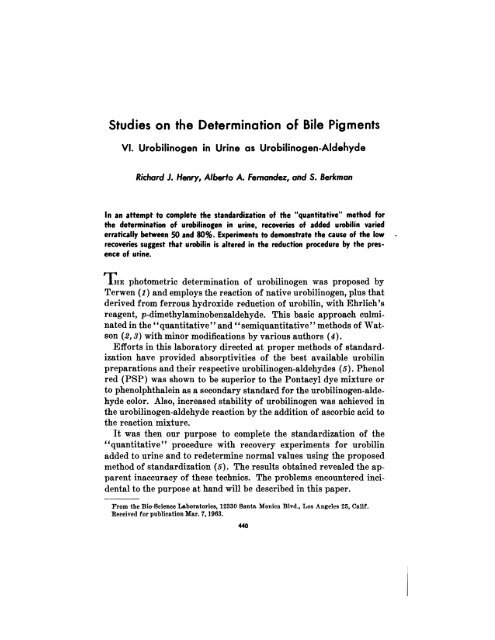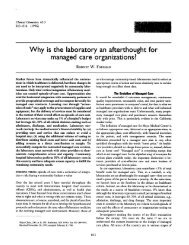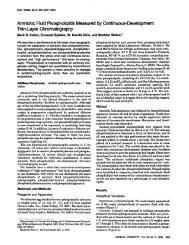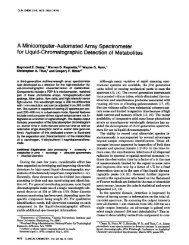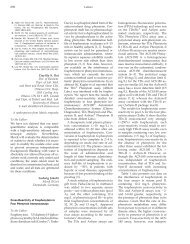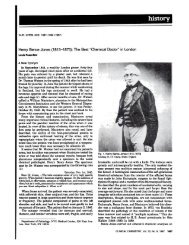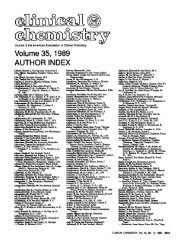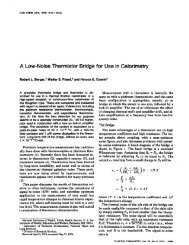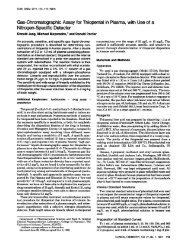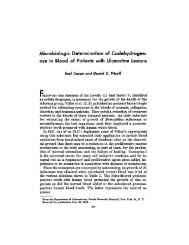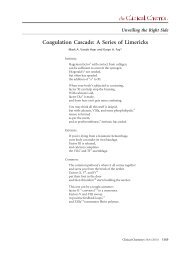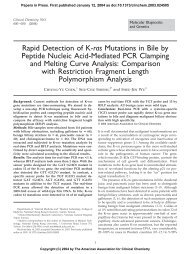Studies on the Determination of Bile Pigments - Clinical Chemistry
Studies on the Determination of Bile Pigments - Clinical Chemistry
Studies on the Determination of Bile Pigments - Clinical Chemistry
You also want an ePaper? Increase the reach of your titles
YUMPU automatically turns print PDFs into web optimized ePapers that Google loves.
<str<strong>on</strong>g>Studies</str<strong>on</strong>g> <strong>on</strong> <strong>the</strong> Determinati<strong>on</strong> <strong>of</strong> <strong>Bile</strong> <strong>Pigments</strong><br />
VI. Urobilinogen in Urine as Urobilinogen-Aldehyde<br />
Richard J. Henry, Alberto A. Fernandez, and S. Berkman<br />
In an attempt to complete <strong>the</strong> standardizati<strong>on</strong> <strong>of</strong> <strong>the</strong> “quantitative” method for<br />
<strong>the</strong> determinati<strong>on</strong> <strong>of</strong> urobilinogen in urine, recoveries <strong>of</strong> added urobilin varied<br />
erratically between 50 and 80%. Experiments to dem<strong>on</strong>strate <strong>the</strong> cause <strong>of</strong> <strong>the</strong> low<br />
recoveries suggest that urobilin is altered in <strong>the</strong> reducti<strong>on</strong> procedure by <strong>the</strong> presence<br />
<strong>of</strong> urine.<br />
THE photometric determinati<strong>on</strong> <strong>of</strong> urobilinogen was proposed by<br />
Terwen (i) and employs <strong>the</strong> reacti<strong>on</strong> <strong>of</strong> native urobilinogen, plus that<br />
derived from ferrous hydroxide reducti<strong>on</strong> <strong>of</strong> urobilin, with Ehrlich’s<br />
reagent, p-dimethylaminobenzaldehyde. This basic approach culminated<br />
in <strong>the</strong> “quantitative” and “semiquantitative” methods <strong>of</strong> Wats<strong>on</strong><br />
(2,3) with minor modificati<strong>on</strong>s by various authors (4).<br />
Efforts in this laboratory directed at proper methods <strong>of</strong> standardizati<strong>on</strong><br />
have provided absorptivities <strong>of</strong> <strong>the</strong> best available urobilin<br />
preparati<strong>on</strong>s and <strong>the</strong>ir respective urobilinogen-aldehydes (5). Phenol<br />
red (PSP) was shown to be superior to <strong>the</strong> P<strong>on</strong>tacyl dye mixture or<br />
to phenolphthalein as a sec<strong>on</strong>dary standard for <strong>the</strong> urobilinogen-aldehyde<br />
color. Also, increased stability <strong>of</strong> urobilinogen was achieved in<br />
<strong>the</strong> urobilinogen-aldehyde reacti<strong>on</strong> by <strong>the</strong> additi<strong>on</strong> <strong>of</strong> ascorbic acid to<br />
<strong>the</strong> reacti<strong>on</strong> mixture.<br />
It was <strong>the</strong>n our purpose to complete <strong>the</strong> standardizati<strong>on</strong> <strong>of</strong> <strong>the</strong><br />
“quantitative” procedure with recovery experiments for urobilin<br />
added to urine and to redetermine normal values using <strong>the</strong> proposed<br />
method <strong>of</strong> standardizati<strong>on</strong> (5). The results obtained revealed <strong>the</strong> apparent<br />
inaccuracy <strong>of</strong> <strong>the</strong>se technics. The problems encountered incidental<br />
to <strong>the</strong> purpose at hand will be described in this paper.<br />
From <strong>the</strong> Bio-Seienee Laboratories, 12330 Santa. M<strong>on</strong>ica Blvd., Los Angeles 25, Calif.<br />
Received for publicati<strong>on</strong> Mar. 7, 1963.<br />
440
Vol. 10, No. 5, 1964 DETERMINATION OF UROBILINOGEN 441<br />
Experimental<br />
Preparati<strong>on</strong> <strong>of</strong> Crystalline Reference Urobilin<br />
The procedure outlined by Wats<strong>on</strong> (6) for <strong>the</strong> preparati<strong>on</strong> <strong>of</strong> i-<br />
urobilin hydrochloride was follo’wed. This involves: (1) reducti<strong>on</strong> <strong>of</strong><br />
bilirubin with sodium amalgam in alkaline soluti<strong>on</strong>; (2) extracti<strong>on</strong><br />
<strong>of</strong> <strong>the</strong> product, mesobilirubinogen, with petroleum e<strong>the</strong>r; (3) oxidati<strong>on</strong><br />
to i-urobilin with an aqueous soluti<strong>on</strong> <strong>of</strong> iodine, with c<strong>on</strong>comitant<br />
extracti<strong>on</strong> <strong>of</strong> <strong>the</strong> urobilin into <strong>the</strong> aqueous phase; (4) acidificati<strong>on</strong> and<br />
extracti<strong>on</strong> with chlor<strong>of</strong>orm; and (5) crystallizati<strong>on</strong> from chlor<strong>of</strong>ormacet<strong>on</strong>e<br />
soluti<strong>on</strong>.<br />
Assay <strong>of</strong> Urines by a Modified “Quantitative” Procedure<br />
In order to ensure best possible reducti<strong>on</strong> to urobilinogen and stability<br />
<strong>the</strong>reafter, some additi<strong>on</strong>s were made to Wats<strong>on</strong>’s procedure:<br />
Twenty milliliters <strong>of</strong> ferrous hydroxide filtrate was prepared by <strong>the</strong><br />
usual means. This was centrifuged and <strong>the</strong> supernatant soluti<strong>on</strong> was<br />
decanted into a tube c<strong>on</strong>taining 200 mg. <strong>of</strong> ascorbic acid. This soluti<strong>on</strong><br />
was <strong>the</strong>n filtered into ano<strong>the</strong>r tube, 100 mg. <strong>of</strong> potassium borohydride<br />
was added, and <strong>the</strong> pH was adjusted to 7-8. Borohydride was found to<br />
aid in <strong>the</strong> complete reducti<strong>on</strong> <strong>of</strong> urobilinogen, as evidenced by <strong>the</strong> more<br />
complete removal <strong>of</strong> <strong>the</strong> 490 m peak <strong>of</strong> urobilin in an acidified aliquot<br />
<strong>of</strong> <strong>the</strong> filtrate (Fig. 1). After several minutes, <strong>the</strong> pH was adjusted to<br />
.500<br />
.400<br />
Fig. 1. Effect <strong>of</strong> potassium<br />
borohydride treatment <strong>on</strong> fil- .oo<br />
trate from reducti<strong>on</strong> <strong>of</strong> urobilin E<br />
A<br />
with ferrous hydroxide: Curve 200<br />
A indicates no borohydride <<br />
treatment; Curve B, borohydride<br />
used. 100<br />
C I I<br />
450 475 525<br />
mu<br />
4.0 and a suitable aliquot was taken for extracti<strong>on</strong>, as per Balikov (4).<br />
Additi<strong>on</strong>al precauti<strong>on</strong>s <strong>of</strong> working in subdued artificial light and with<br />
minimal delay at each step were observed.
442 HENRY fT AL. <strong>Clinical</strong> <strong>Chemistry</strong><br />
Direct C<strong>on</strong>densati<strong>on</strong> <strong>of</strong> Ehrlich’s Reagent with Reduced Urine<br />
To 1 volume <strong>of</strong> filtrate, prepared as in <strong>the</strong> “quantitative” procedure,<br />
was added 1 volume <strong>of</strong> Ehrlich’s reagent. The soluti<strong>on</strong> was<br />
mixed and 2 volumes <strong>of</strong> saturated sodium acetate was added. Washing<br />
<strong>the</strong> colored soluti<strong>on</strong> with several porti<strong>on</strong>s <strong>of</strong> benzene, followed by 1<br />
porti<strong>on</strong> <strong>of</strong> petroleum e<strong>the</strong>r removed most n<strong>on</strong>specific color. Tlrobilinogen-aldehyde<br />
was <strong>the</strong>n extracted with chlor<strong>of</strong>orm.<br />
Results<br />
Preparati<strong>on</strong><br />
<strong>of</strong> Urobilin<br />
The following observati<strong>on</strong>s were made while preparing <strong>the</strong> reference<br />
urobilin:<br />
1. Reducti<strong>on</strong> <strong>of</strong> bilirubin with sodium amalgam gave two fracti<strong>on</strong>s<br />
positive to Ehrlich’s reagent, <strong>on</strong>ly <strong>on</strong>e <strong>of</strong> which was extractable into<br />
petroleum e<strong>the</strong>r at pH 4.<br />
2. After iodine oxidati<strong>on</strong> to obtain urobilin from mesobilirubinogen<br />
and extracti<strong>on</strong> into water, it was found that some mesobilirubinogen<br />
remained in <strong>the</strong> petroleum e<strong>the</strong>r-i.e., complete oxidati<strong>on</strong> had not been<br />
achieved with <strong>the</strong> <strong>the</strong>oretical amount <strong>of</strong> iodine and <strong>the</strong> iodine was c<strong>on</strong>sumed<br />
in side reacti<strong>on</strong>s. Subsequent exposure <strong>of</strong> <strong>the</strong> soluti<strong>on</strong> to diffuse<br />
sunlight gave additi<strong>on</strong>al urobilin. The two fracti<strong>on</strong>s <strong>of</strong> pigment were<br />
isolated and gave identical spectra and absorptivities in acid-methanol<br />
and also as urobilinogen-aldehyde after rereducti<strong>on</strong> to <strong>the</strong> chromogen.<br />
3. If <strong>the</strong> oxidati<strong>on</strong> in petroleum e<strong>the</strong>r was promoted by sunlight,<br />
<strong>the</strong> product had to be extracted with water as it formed, since prol<strong>on</strong>ged<br />
exposure to sunlight produced a product which was insoluble<br />
in dilute 1101. llrobilin would be expected to be soluble in HC1. Both<br />
products exhibited spectra in acid-methanol which were identical to<br />
that <strong>of</strong> urobilin.<br />
4. The “biliviolin” side-products, formed when <strong>the</strong> oxidati<strong>on</strong> <strong>of</strong><br />
mesobilirubinogen was promoted by sunlight or by iodine, were <strong>of</strong><br />
different colors, depending <strong>on</strong> which <strong>of</strong> <strong>the</strong>se oxidati<strong>on</strong> technics was<br />
used.<br />
5. The “urobilinogen-aldehyde” obtained from our “urobilin”<br />
preparati<strong>on</strong> revealed two fracti<strong>on</strong>s. The minor fracti<strong>on</strong> was extractable<br />
into benzene from aqueous soluti<strong>on</strong>, whereas <strong>the</strong> major fracti<strong>on</strong><br />
(about 90% <strong>of</strong> total) remained in <strong>the</strong> aqueous phase and was subsequently<br />
extractable by chlor<strong>of</strong>orm.
Vol. 10, No. 5, 1964 DETERMINATION OF UROBILINOGEN 443<br />
Assay <strong>of</strong> Iirines by <strong>the</strong> Modified “Quantitative” Procedure<br />
“Pure urobilin” soluti<strong>on</strong>s taken through <strong>the</strong> procedure as described<br />
for urine yielded a mean recovery <strong>of</strong> 90%. The final colored soluti<strong>on</strong>s<br />
were quantitated by comparis<strong>on</strong> with standards not taken through<br />
<strong>the</strong> extracti<strong>on</strong> procedure and which have been previously described<br />
(5). However, recoveries <strong>of</strong> urobilin from urine varied erratically<br />
from 50 to 80% <strong>of</strong> <strong>the</strong> added urobilin (Table 1).<br />
Precisi<strong>on</strong> <strong>on</strong> normal urines c<strong>on</strong>taining low levels <strong>of</strong> urobilinogen<br />
was poor, with duplicates differing as much as 65%.<br />
Examinati<strong>on</strong> <strong>of</strong> absorpti<strong>on</strong> spectra <strong>of</strong> some reducti<strong>on</strong> mixtures <strong>of</strong><br />
urobilin with urine revealed a peak in <strong>the</strong> 512 m regi<strong>on</strong> which was<br />
obtained nei<strong>the</strong>r from <strong>the</strong> reduced urine nor from reduced urobilin<br />
al<strong>on</strong>e (Fig. 2).<br />
Table 1. REcOVERY OF UltomLIN AS UROBILINOGEN FROM PURE SOLUTIONS AND FROM URINE<br />
Added in filtrate Found in filtrate<br />
Urobilin extracted (mg.) extracted (mg.) Recovery (%)<br />
In pure aq. aol.<br />
A 0.065 0.064 99<br />
B 0.060 0.057 95<br />
C 0.065 0.053 82<br />
D 0.063 0.052 83<br />
E 0.089 0.082 92<br />
Added to urine<br />
A 0.105 0.068 65<br />
B 0.095 0.074 78<br />
C 0.095 0.064 67<br />
D 0.091 0.045 49<br />
Urobiinogen<br />
Added to urine 0.150 0.155 103<br />
Fig. 2. Reducti<strong>on</strong> mixtures <strong>of</strong><br />
urine (A), urobilin (B), and<br />
urine plus urobilin (C).<br />
a<br />
0<br />
f .100<br />
0<br />
4<br />
450 475<br />
mp
444 HENRY fT AL. <strong>Clinical</strong> <strong>Chemistry</strong><br />
The effect <strong>of</strong> time <strong>of</strong> standing with Ehrlich’s reagent prior to sodium<br />
acetate additi<strong>on</strong> <strong>on</strong> <strong>the</strong> urobilinogen aldehyde color is shown<br />
in Fig. 3.<br />
:1<br />
E<br />
.500<br />
.430<br />
0<br />
4<br />
Fig. 3. Effect <strong>of</strong> prol<strong>on</strong>ged<br />
standing <strong>of</strong> urobilinogen with<br />
Ehrlieh’s reagent in HC1.<br />
.460<br />
0 2 4 6 6 10<br />
Mnutes before a4it<strong>on</strong> <strong>of</strong> NoOAc<br />
Direct C<strong>on</strong>densati<strong>on</strong> <strong>of</strong> Ehrlich’s Reagent with Reduced Urine<br />
In order to eliminate <strong>the</strong> problems <strong>of</strong> incomplete extracti<strong>on</strong> and<br />
losses arising from oxidatioti <strong>of</strong> urobilinogen or urobilin in <strong>the</strong> “quantitative”<br />
procedure, a method was devised wherein <strong>the</strong> color reacti<strong>on</strong><br />
was performed directly <strong>on</strong> a urine filtrate in <strong>the</strong> same manner that<br />
Wats<strong>on</strong>’s “semiquantitative” method is applied to urine. A subsequent<br />
extracti<strong>on</strong> was made to separate <strong>the</strong> urobilinogen-aldehyde<br />
from o<strong>the</strong>r Ehrlich-positive reacti<strong>on</strong> products. Details <strong>of</strong> <strong>the</strong> method<br />
have been given above. Table 2 shows that urobilinogen added to urine<br />
could not be quantitatively recovered in this procedure. The same soluti<strong>on</strong>s,<br />
analyzed 24 hr. later, showed a loss <strong>of</strong> urobilinogen in <strong>the</strong> aqueous<br />
soluti<strong>on</strong>; <strong>the</strong> urine, however, exhibited an apparent increase in<br />
urobilinogen.<br />
Discussi<strong>on</strong><br />
Recogniti<strong>on</strong> that difficulties are encountered ill <strong>the</strong> testing <strong>of</strong> urine<br />
for urobilin and urobilinogen is not new. Tn 1936, Wats<strong>on</strong> (2) stated<br />
that “. . . <strong>the</strong> reducti<strong>on</strong> <strong>of</strong> urobilin to urobilinogen is in some degree<br />
hindered in <strong>the</strong> urine” and that “because urobilinogen is a labile<br />
chromogen, it is certain that no quantitative method can aspire to more<br />
than approximate values.” The present data seem to substantiate this<br />
and seem also to indicate that <strong>the</strong> oxidati<strong>on</strong> <strong>of</strong> urohilinogen goes iii<br />
part to products o<strong>the</strong>r than urohilin. According to our observati<strong>on</strong>s,
Vol. 10, No. 5, 1964 DETERMINATION OF UROBILINOGEN 445<br />
exposure <strong>of</strong> chromogeii extracts even to diffuse sunlight can produce<br />
pigments o<strong>the</strong>r than urobilin (“biliviolins”). Doubt has thus been<br />
cast up<strong>on</strong> <strong>the</strong> fundamental assumpti<strong>on</strong> <strong>of</strong> <strong>the</strong> test-viz., that urobilinogen<br />
which has underg<strong>on</strong>e oxidati<strong>on</strong> in <strong>the</strong> urine can again be reduced<br />
to urobiliriogen; indeed, this suspici<strong>on</strong> has been raised by Wats<strong>on</strong><br />
(7) and by Heilmeyer (8).<br />
The data in Table 1 suggest that it is <strong>the</strong> urine itself which interferes<br />
with <strong>the</strong> reducti<strong>on</strong> <strong>of</strong> urobilin. The good recovery <strong>of</strong> urobilinogen<br />
added to urine lends support to this hypo<strong>the</strong>sis. Spectrophotometric<br />
data presented also support this possibility; Fig. 2 shows that <strong>the</strong> reducti<strong>on</strong><br />
<strong>of</strong> urobilin in <strong>the</strong> presence <strong>of</strong> urine can produce ano<strong>the</strong>r substance<br />
different from urobilinogen (Curve C). In additi<strong>on</strong>, recovery<br />
experiments using direct Ehrlich’s aldehyde reacti<strong>on</strong> in urine suggest<br />
<strong>the</strong> c<strong>on</strong>cept <strong>of</strong> a negative interference: In <strong>the</strong>se experiments, <strong>the</strong> observati<strong>on</strong><br />
that <strong>the</strong> apparent urobilinogn level was somewhat increased<br />
when samples had stood for 24 hr. suggests that <strong>the</strong> interfering factor<br />
itself changes with time and that low recoveries from urine are due<br />
primarily to such interference ra<strong>the</strong>r than to an irreversible oxidati<strong>on</strong><br />
<strong>of</strong><br />
urobilinogen.<br />
To be sure, elevated levels <strong>of</strong> urobilinogen in disease states such as<br />
infectious hepatitis would not go undetected, despite <strong>the</strong> analytical<br />
problems ; however, in obstructive jaundice, where diminished amounts<br />
<strong>of</strong> urobilinogen are excreted because <strong>of</strong> <strong>the</strong> absence <strong>of</strong> intestinal re-<br />
Table 2. RECOVERY OF UROBILINOGEN FROM URINE BY DIRECT REACTION WITH EHRLICH’S<br />
REAGENT<br />
Sample preparati<strong>on</strong> (nil.) Am, tm. CHClii* --<br />
20 mg./<br />
100 ml.<br />
Sample Water Urine URGt<br />
Initial teat 24-hr. teat<br />
Urine 5 45 - 0.006 0.006<br />
*Readings represent “urobilinogen-aldebyde” extracted in 24 ml. chlor<strong>of</strong>orm from reducti<strong>on</strong><br />
<strong>of</strong> 7.5 ml. sample. Samples were preserved overnight at 30#{176} with 0.1 gm. Na,00a per 10 ml.<br />
sample and overlayed with 3 ml. mineral oil.<br />
tA 20-mg./100 ml. soluti<strong>on</strong> <strong>of</strong> urobilinogen was prepared by borohydride reducti<strong>on</strong> <strong>of</strong> urobilin.<br />
The soluti<strong>on</strong> was <strong>the</strong>n acidified with HCI to decompose <strong>the</strong> excess potassium horohydride.<br />
0.005 0.006<br />
Urohilinogen 45 - 5 0.500 0.380<br />
0.470 0.360<br />
Urine plus - 45 5 0.210 0.275<br />
urohilinogen 0.200 0.300
446 HENRY ET AL. <strong>Clinical</strong> <strong>Chemistry</strong><br />
ducti<strong>on</strong> <strong>of</strong> bilirubin, or in o<strong>the</strong>r states with diminished bile formati<strong>on</strong>,<br />
it would seem unwise to place much faith in <strong>the</strong>se methods.<br />
It would appear that improvements in <strong>the</strong> urobilinogen-aldehyde<br />
method for <strong>the</strong> determinati<strong>on</strong> <strong>of</strong> urobilin and urobilinogen in urine<br />
will depend up<strong>on</strong> separati<strong>on</strong> <strong>of</strong> <strong>the</strong>se substances from <strong>the</strong> interfering<br />
materials prior to chemical manipulati<strong>on</strong>. C<strong>on</strong>venient methods for this<br />
purpose are not presently available. Until such improvements are<br />
made in <strong>the</strong> “quantitative” technic, <strong>the</strong> urobilinogen c<strong>on</strong>centrati<strong>on</strong>s<br />
obtained by it are <strong>of</strong> very questi<strong>on</strong>able value, and it would seem that it<br />
is sufficient for clinical purposes to use <strong>the</strong> “semiquantitative” technic,<br />
even though it is subject to serious problems <strong>of</strong> specificity and may be<br />
affected by <strong>the</strong> same inhibiting substances.<br />
References<br />
1. Terwen, A. .1. L., Deut. Arch. kim. Med. 149, 72 (1925).<br />
2. Wats<strong>on</strong>, C. J., Am. J. Clin. Pathol. 6,458 (1936).<br />
3. Wats<strong>on</strong>, C. J., Schwartz, S., Sborov, V., and Bertie, E., Am. J. CUn. Paihol. 14, 605 (1944).<br />
4. Balikov, B., Standard Methods <strong>of</strong> <strong>Clinical</strong> <strong>Chemistry</strong>, (Vol. 2), Acad. Press, 1958, p. 192.<br />
5. Henry, R. J., Jacobs, S. L. and Berkman, S., Clin. Chem. 7, 231 (1961).<br />
6. Wats<strong>on</strong>, C. 3., J. Bid. Chem. 200, 691 (1953)<br />
7. Wats<strong>on</strong>, C. J., and Hawkins<strong>on</strong>, V., Am. J. Clin. Pathol. 17, 108 (1947).<br />
8. Heilmeyer, L., Z. Ges. exptl. Med. 76, 220 (1931).


